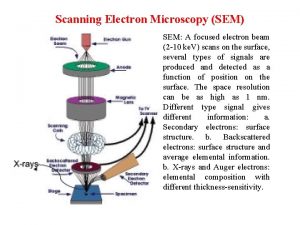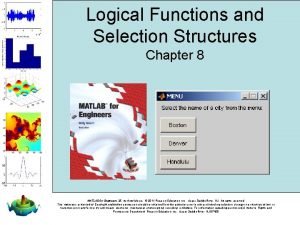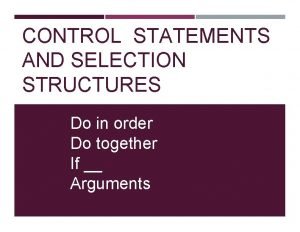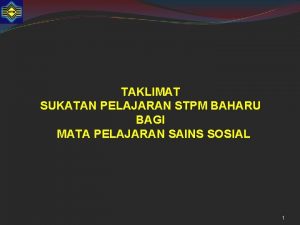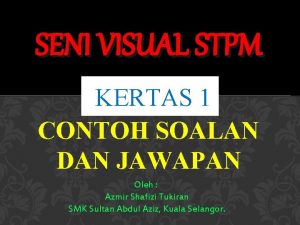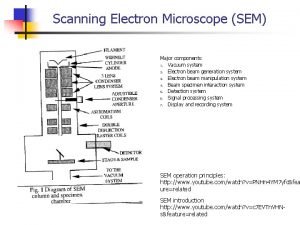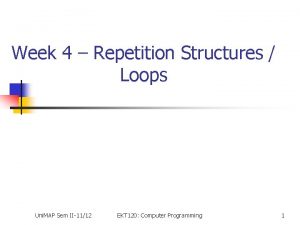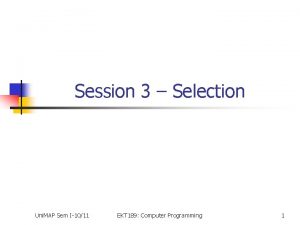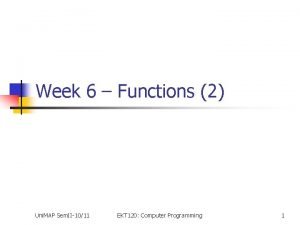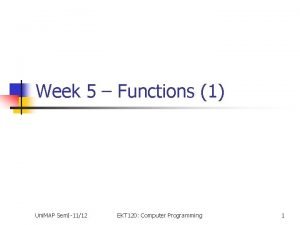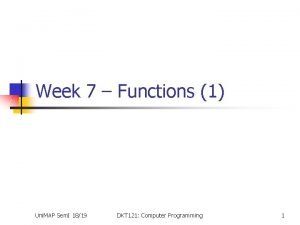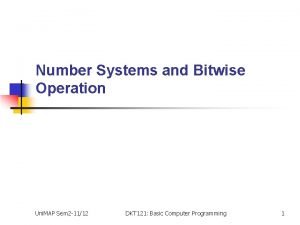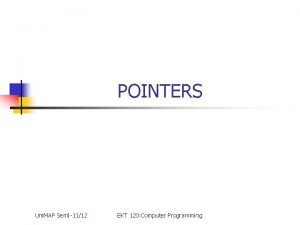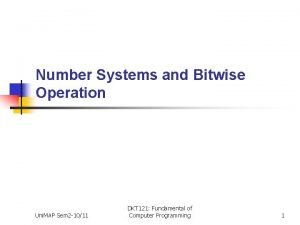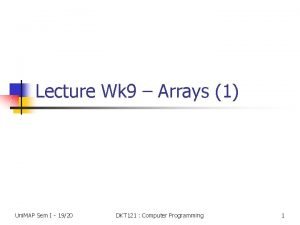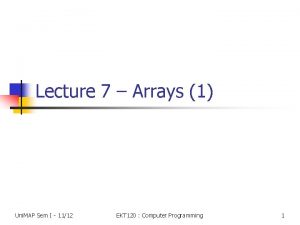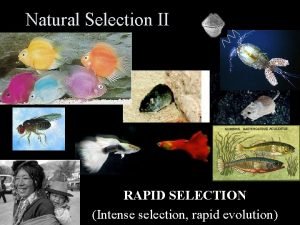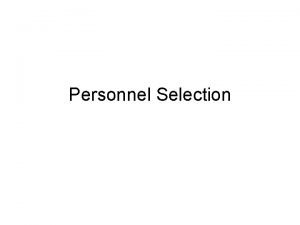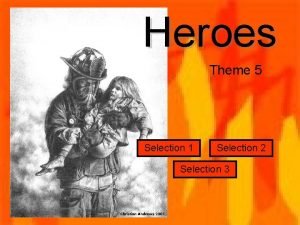Week 4 Selection Structures Uni MAP Sem I1920
































- Slides: 32

Week 4 – Selection Structures Uni. MAP Sem I-19/20 DKT 121: Computer Programming 1

Outline n n n n n Recall selection control structure Types of selection One-way selection Two-way selection Multi-selection Compound statement Nested if Conditional operator Switch structure 2

Selection Statements n n n Used to control the flow of a program Also called as decision or branches Branches are conditions or choices used to enable selection of program flow 3

Recall. . Selection Structure n n Used to choose among alternative courses of action C has three types: if, if. . else, and switch 4

Types of selection n n One-way selection = if Two-way selection = if. . else Multi-selection Nested if {if dalam if} Switch structure = switch 5

1) The if selection structure n if structure is a single-entry/single-exit structure If student’s grade is greater than or equal to 60 Print “Pass” f. Grade >= 60 true print “Pass” false 6

One-way Selection = if n n n In C, a condition is represented by a logical (Boolean) expression true and false are logical (Boolean) values The syntax of one-way selection is: n n n if (expression) statement If the value of the expression is true, statement is executed; if false, statement is not executed and the computer goes on to the next statement in the program. 7

One-way Selection = if If student’s grade is greater than or equal to 60 Print “Pass” f. Grade >= 60 true print “Pass” false 8

One-way Selection = if …. . if(f. Grade >= 60) printf(“Pass”); …. . 9

One-way Selection = if n Another example: char c. Grade; …… if(f. Markah>= 90) c. Grade = 'A'; …… …. . . printf(“Grade is : %cn”, c. Grade); 10

One-way Selection = if n Another example: n if (temperature is greater than 70 degree and it is not raining) n recommended activity is golfing bool rain=false; … if((f. Temp > 70) && !(rain)) printf(“recommended activity is golfing”); 11

One-way Selection = if n Common Errors n if f. Score >= 90 //no parentheses c. Grade = 'A'; n if(f. Score >= 90); //; not here c. Grade = 'A'; 12

2) The if. . else selection structure n Specifies an action to be performed both when the condition is true and when it is false If student’s grade is greater than or equal to 60 print “Pass” else print “Fail” Else part false print “Fail” f. Grade >= 60 true If part print “Pass” 13

Two-way Selection = if. . else n The syntax of two-way selection is: n n n if (expression) statement 1; else statement 2; If the value of the expression is true, statement 1 is executed; if false, statement 2 is executed 14

Two-way Selection = if. . else If student’s grade is greater than or equal to 60 print “Pass” else print “Fail” false print “Fail” f. Grade >= 60 true print “Pass” 15

Two-way Selection = if. . else ……… if(f. Grade >=60) printf(“Pass”); else printf(“Fail”); …… 16

Two-way Selection = if. . else n Another example: if (f. Hour > 40. 0) //Line 1 f. Wages = 40. 0 * f. Rate +1. 5 * f. Rate * (hour - 40. 0); //Line 2 else //Line 3 f. Wages = f. Hour * f. Rate; //Line 4 n n If f. Hour is 50, then the statement at Line 2 is executed If f. Hour is 30, then the statement at Line 4 is executed 17

3) Multi-selection = if-else if n The syntax is: if(expression 1 ) statement 1; An “if…. else if” control structure shifts program control, step by step, through a series of statement blocks. else if(expression 2) statement 2; else if(expression 3) statement 3; … else statement n; 18

Multi-selection = if-else if n E. g. temp >30 0 c f. Temp >30 display hot false f. Temp > 20 20 -30 0 c mild false 10 -20 0 c cold f. Temp >10 <10 0 c very cold true Print “hot” Print “mild” Print “cold” false Print “very cold” 19

Multi-selection = if-else if if(f. Temp > 30) printf( “hotn”); else if(f. Temp >=20 && f. Temp<=30) printf( “mildn”); else if(f. Temp >=10 && f. Temp < 20) printf(“coldn”); else printf( “very coldn”); 20

Compound (Block of) Statement n A compound statement (also called a block of statements) takes the form of { n statement 1; statement 2; . . . statement n; } It is considered a single statement 21

Compound (Block of) Statement Example: if (i. Age > 18) { n printf("Eligible to voten“); printf("No longer a minorn“); } else { } printf("Not eligible to voten“); printf(“Still a minorn”); 22

4) Nested if n n **lab Structure Task 3. 3 When one control statement is within another, it is said to be nested if(expression 1) if(expression 2) statement 1; OR n if(expression 1) { statement 1; if(expression 2) statement 2; } 23

Nested if n Example: if (f. Temperature >= 50) { if (f. Temperature >= 80) printf( "Good day for swimming. n”); else printf( "Good day for golfing. n“); } else printf("Good day to play tennis. n“); 24

Nested if Another example #include <stdio. h> void main (void) { int i. Day; float f. Time; n Output Type the day and time of interest Keyboard input 3 10. 00 Relax printf ("Type the day and time of interestnn"); scanf (" %d %f ", &i. Day, &f. Time); if (i. Day <= 5) { if (f. Time <= 9. 00) printf else printf } else { if (f. Time <= 8. 00) printf else printf } } (" Work nn"); (" Relax nn"); (" Sleep nn"); (" Have Fun nn"); 25

The Conditional Operator (? : ) n n n The syntax of using the conditional operator is: expression 1 ? expression 2 : expression 3; This is called a conditional expression. The statement: if (a >= b) max = a; else max = b; n Is equivalent to the statement: max = (a >= b) ? a : b; 26

5) switch Structures n n Similar to if-else if control structure The general form (syntax): switch (expression) { case value 1: statement 1; break; case value 2: statement 2; break; . . . case valuen: statementn; break; default: statements; } 27

switch Structures n n n The break statement has a special meaning and may or may not appear after each statement. In C, switch, case, break, and default are reserved words. In a switch structure, first the expression is evaluated. The value of the expression is then used to perform the corresponding action. 28

switch Structures n n n The expression is usually an identifier. The value of the expression can be only integral. The expression is sometimes called the selector. Its value determines which statement is selected for execution. A particular case value should appear only once. One or more statements may follow a case label, so you do not need to use braces to turn multiple statements into a single compound statement. The break statement may or may not appear after each statement. 29

switch Structures n **lab Structure Task 3. 4 Example: switch (c. Grade) { } n case 'A': printf("The grade is A. “); break; case 'B': printf("The grade is B. “); break; case 'C': printf("The grade is C. “); break; case 'D': printf("The grade is D. “); break; case 'F': printf("The grade is F. “); break; default: printf("The grade is invalid. “); where, c. Grade is a variable of the type char. If the value of c. Grade is, say 'A', the output is The grade is A. 30

switch Structures n The switch statement executes according to the following rules: n n n When the value of the expression is matched against a case value (also called a label), the statements execute until either a break statement is found or the end of the switch structure is reached. If the value of the expression does not match any of the case values, the statements following the default label execute. If the switch structure has no default label, and if the value of the expression does not match any of the case values, the entire switch statement is skipped. A break statement causes an immediate exit from the switch structure 31

What’s wrong? ? 32
 Sem sem sem
Sem sem sem Atividade sobre paródia com gabarito 6 ano
Atividade sobre paródia com gabarito 6 ano O que motivou felipe a reduzir as suas mentiras
O que motivou felipe a reduzir as suas mentiras Week by week plans for documenting children's development
Week by week plans for documenting children's development Homologous structures example
Homologous structures example Matlab selection structure
Matlab selection structure Selection structures
Selection structures Balancing selection vs stabilizing selection
Balancing selection vs stabilizing selection Artificial selection vs natural selection
Artificial selection vs natural selection K selection r selection
K selection r selection Natural selection vs artificial selection
Natural selection vs artificial selection Artificial selection vs natural selection
Artificial selection vs natural selection What is stablizing selection
What is stablizing selection Clumped dispersion
Clumped dispersion Natural selection vs artificial selection
Natural selection vs artificial selection Two way selection and multiway selection in c
Two way selection and multiway selection in c Multiway selection
Multiway selection Mass selection and pure line selection
Mass selection and pure line selection Sukatan bm stpm penggal 2
Sukatan bm stpm penggal 2 Cara menjawab esei seni visual stpm
Cara menjawab esei seni visual stpm Strategic enrolment management
Strategic enrolment management Sem
Sem Sem components
Sem components Sem cam e jafet
Sem cam e jafet Organização sem fronteiras
Organização sem fronteiras Aacrao sem
Aacrao sem Block diagram of sem
Block diagram of sem O livro sem palavras
O livro sem palavras Boite outils sem
Boite outils sem David kenny sem
David kenny sem Sem depth of field
Sem depth of field Sem vs tem
Sem vs tem Sem fé é impossivel agradar a deus
Sem fé é impossivel agradar a deus
